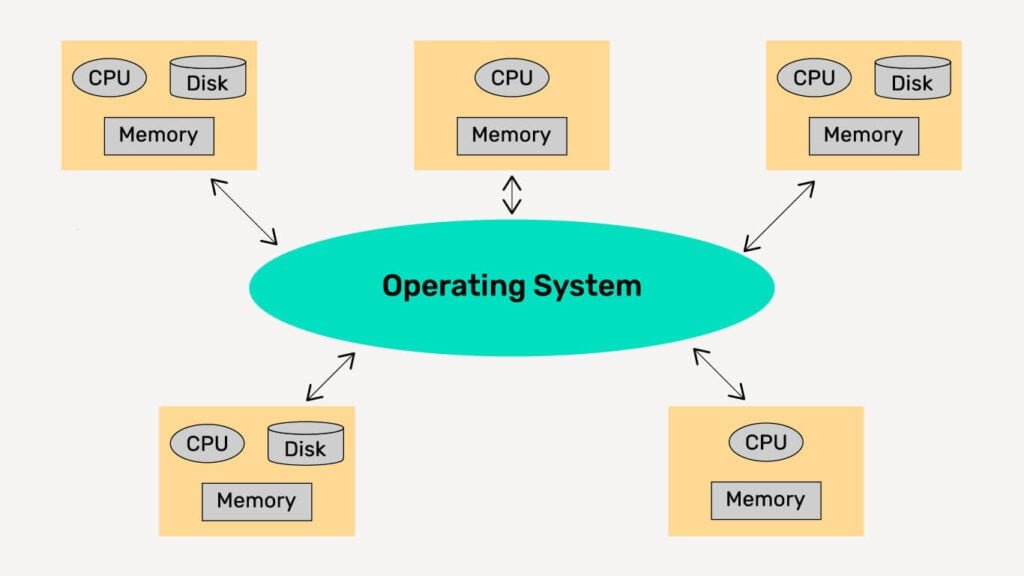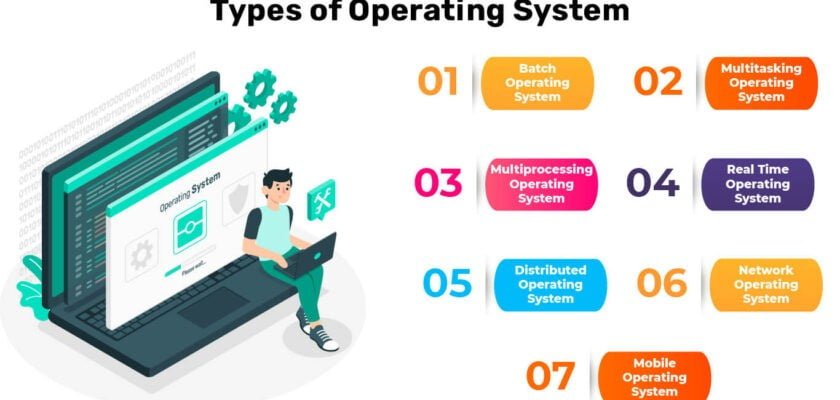In this article, we will learn about different types of Operating System. If you don’t know what is an Operating System, the Functions, and Features of them. Then, you can see our Operating System article.
Types of Operating System
Following are the popular types of OS (Operating System):
- Batch Operating System
- Multitasking/Time Sharing Operating System
- Multiprocessing Operating System
- Real Time Operating System
- Distributed Operating System
- Network Operating System
- Mobile Operating System
Batch Operating System
Some computer processes are very lengthy and time-consuming. To speed the same process, a job with a similar type of needs is batched together and run as a group. The user of a batch operating system never directly interacts with the computer. In this type of OS, every user prepares his or her job on an offline device like a punch card and submits it to the computer operator. The operator takes similar jobs having the same requirement and groups them into batches. It is the responsibility of the operator to sort jobs with similar needs.

Advantage of Batch Operating System
- It is very difficult to guess or know the time required for any job to complete. Processors of the batch systems know how long the job would be when it is in queue.
- Multiple users can share the batch systems
- The idle time for the batch system is very less
- It is easy to manage large work repeatedly in batch systems
Disadvantage of Batch Operating System
- The computer operators should be well known with batch systems
- Batch systems are hard to debug
- It is sometimes costly
- The other jobs will have to wait for an unknown time if any job fails
Examples of Batch Operating System: Payroll System, Bank Statements, etc.
Time Sharing Operating System
Each task is given some time to execute so that all the tasks work smoothly. Each user gets the time of CPU as they use a single system. These systems are also known as Multitasking System, Fair Share, or Multiprogramming with Round Robin System. The task can be from a single user or a different user also. The time that each task gets to execute is called quantum. After this time interval is over OS switches over to the next task.

Advantages of Time-Sharing OS:
- Each task gets an equal opportunity
- Fewer chances of duplication of software
- CPU idle time can be reduced
Disadvantages of Time-Sharing OS:
- Reliability problem
- One must have to take care of the security and integrity of user programs and data
- Data communication problem
Examples of Time-Sharing OSs are Multics, Unix, etc.
Multiprocessing Operating System
Multiple processes can be done simultaneously or parallelly in multiple CPUs.
Real Time Operating System
These types of OSs serve real-time systems. The time interval required to process and respond to inputs is very small. This time interval is called response time.
There are two types of Real-Time OS. These are:
i. Soft Real-Time OS: The processes should be completed within the time-bound. These OS’s are for applications where the time constraint is less strict.
ii. Hard Real-Time OS: The process should be completed at the exact time. These OS’s are meant for applications where time constraints are very strict and even the shortest possible delay is not acceptable.

Advantages of RTOS:
- Maximum Consumption: Maximum utilization of devices and systems, thus more output from all the resources.
- Task Shifting: The time assigned for shifting tasks in these systems is very less.
- Focus on Application: Focus on running applications and less importance to applications which are in the queue.
- Error Free: These types of systems are error-free.
- Memory Allocation: Memory Allocation is best managed in these types of systems.
Disadvantages of RTOS:
- Limited Tasks: Very few tasks run at the same time and their concentration is very less on few applications to avoid errors.
- Use heavy system resources: Sometimes the system resources are not so good and they are expensive as well.
- Complex Algorithms: The algorithms are very complex and difficult for the designer to write on.
- Device driver and interrupt signals: It needs specific device drivers and interrupts signals to respond earliest to interrupts.
- Thread Priority: It is not good to set thread priority as these systems are very less prone to switching tasks.
Example: Scientific experiments, medical imaging systems, industrial control systems, weapon systems, robots, air traffic control systems, missile systems, time bombs, etc.
Distributed Operating System
Distributed systems use many processors located in different machines to provide very fast computation to their users. We can say that when various autonomous interconnected computers communicate with each other using a shared communication network is called a distributed operating system.

Advantages of Distributed OS:
- Failure of one will not affect the other network communication, as all systems are independent from each other
- Electronic mail increases the data exchange speed
- Since resources are being shared, computation is highly fast and durable
- Load on host computer reduces
- These systems are easily scalable as many systems can be easily added to the network
- Delay in data processing reduces
Disadvantages of Distributed OS:
- Failure of the main network will stop the entire communication
- To establish distributed systems the language which is used are not well defined yet
- These types of systems are not readily available as they are very expensive. Not only that the underlying software is highly complex and not understood well yet
Examples: LOCUS, etc.
Network Operating System
Network Operating Systems runs on a server. It provides the capability to serve to manage data, users, groups, security, application, and other networking functions. These types of operating systems allow shared access of files, printers, security, applications, and other networking functions over a small private network.

Advantages of Network OS:
- Highly stable centralized servers
- Security concerns are handled through servers
- New technologies and hardware up-gradation are easily integrated into the system
- Server access is possible remotely from different locations and types of systems
Disadvantages of Network OS:
- Servers are costly
- User has to depend on a central location for most operations
- Maintenance and updates are required regularly
Examples: Microsoft Windows Server 2003, Microsoft Windows Server 2008, UNIX, Linux, Mac OS X, Novell NetWare, and BSD, etc.
Mobile OS
Mobile Operating Systems are those OS that is specially designed to power smartphones, tablets, and wearable devices.
Examples: Android, iOS, BlackBerry, Web, watchOS, etc.

